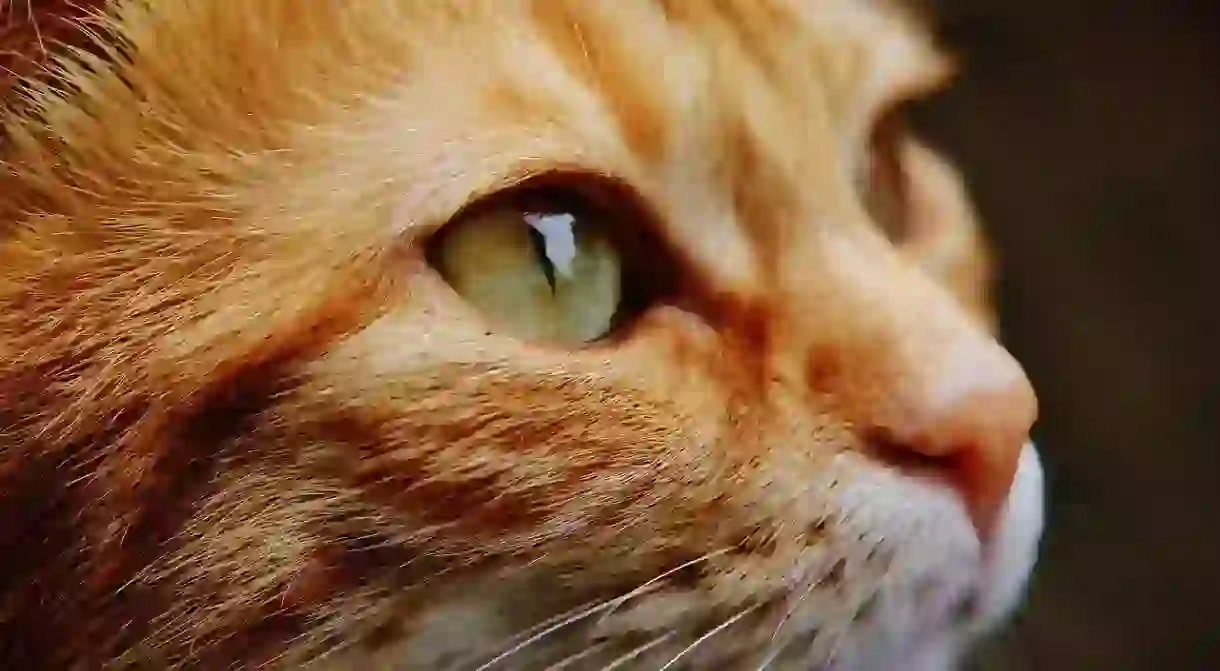10 of Russia's Most Badass Cats

Russia has a long-standing love for feline furballs, and the nation’s cultural landscape is littered with iconic kitties. Immortalised in statues and protectors of art and royalty, Russian cats are cool. From living legends to literary figures, here are the top 10 most badass cats Russia has.
The Russian Blue
Sleek, with a steely blue coat and emerald eyes, Russian blues are as beautiful as they are switched on. These curious animals are loyal and affectionate to their owners and can pick up on human moods. It is believed they originated from the northern port town of Arkhangelsk and were taken to wider Europe by sailors in the late 1800s, later to be recognised as their own class of pedigree in 1912. They are also generally pretty good at playing fetch, making them all the more ace.

Matroskin the Cat
This kitty is a character from the 1978 Soviet children’s animation, Three from Prostokvashino which is based on the children’s book Uncle Fedya, His Dog, and His Cat by Eduard Uspensky. Uncle Fyodor (a serious six-year-old boy) and his talking feline pet, Matroskin, set up house in a village after Uncle Fyodor’s parents refuse to let the child keep the cat, which was initially a stray. Once in the village they are joined by a dog, Sharik, and have many adventures, much to the dismay of the grumpy postman. Matroskin is a very capable and independent cat, and a resourceful and thrifty house keeper, who can sew, bake and play the guitar. Watch part of the film here.

Bayun the Cat
A reoccurring character in Russian fables, Bayun the Cat can lull a human to sleep, so he can either rob or eat them. A representation of the good and bad in us, his voice can also cure illness, should Bayun choose to help people. But he doesn’t. Many warriors and soldiers have tried to capture this cat, to little success. The only object to protect a human from Bayun’s powers is an iron helmet to block out the feline’s dulcet tones.

Hermitage Cats
Since the mid-1700s, felines have resided at the Winter Palace, once a royal residence, and now home to most extensive art collections in the world. Like most animals and pets, Hermitage Cats didn’t survive the Siege of Leningrad and the famine that seized over 600,000 of St Petersburg’s residents. However, at the end of World War II, cats were brought back to the Hermitage and have become beloved fixtures of the museum. Excused from rodent patrol duties nowadays, they are free to laze and stroll about the museum’s back quarters as they please.

A Kitten Named Woof
This puss hails from the ridiculously cute Soviet cartoon about the daily life of an adorable Siamese kitten named after the sound a dog makes – ‘woof’ in English, or ‘gav‘ in Russian. Created between 1976-1982, the stories revolve around making up secret languages with Gav’s lovable puppy friend, experiencing rain for the the first time, wanting to lick the moon and the difficulties a tiny little kitten encounters when its name is the sound of a dog bark. Did we mention how cute it is? Watch a few episodes here.

Kazan Mouse Hunters
As predecessors to the current Hermitage Cats, the cats of Kazan were the original Winter Palace protectors, guarding the royal residents from all rodents. In 1745 Empress Elizabeth, due to a mounting mouse and rat problem, ordered the best feline hunters to be sent to her. Kazan’s resident felines were reputed for their hunting prowess and physical strength and size, and so transported across to St Petersburg, their legacy and adoration evident in the Hermitage Cats of today.
Behemoth
This feline is a member of Satan’s entourage and the huge, demonic cat that descended upon Moscow, creating chaos in Mikhail Bulgakov’s 1967 classic Soviet satire, The Master and Margarita. An obnoxious, sarcastic reprobate and philosopher, Behemoth indulges in vices – vodka, guns, gluttony and basks in his menace and the havoc he creates. His literary role is to represent unchecked human desires, but he is also just a really good character.
https://www.instagram.com/p/BYtvB30BL5i/?tagged=masterandmargarita
A Learned Cat
In the opening lines of Alexander Pushkin’s epic and well-known poem, Ruslan and Ludmila, the learned cat is bound to a green oak, by a gold chain, near the sea. Night and day the cat circles the tree. If the cat walks right he sings a song, if he walks left he tells a story. One of the stories is that of Ruslan and Ludmila, which then the poem regales.
Leopold the Cat
Another Soviet animation, Leopold was a bow-tie wearing, helpful and wise cat in a series by the same name from 1975-1987. Throughout the series he was dogged by two mice – Grey and White, two little forces of evil who do their best, but often fail, to get a rise out of the super chilled, peace-loving feline.

Achilles, 2018 World Cup Oracle
After nailing the predictions at the 2017 Confederations Cup, Hermitage Cat Achilles is set to return to duty at the 2018 World Cup, where he will once again predict competition winners and losers, alongside Nika, the orphaned, football loving polar bear. Blue-eyed, white-haired and deaf, Achilles was chosen for the role because of his social disposition and interrogative character. All Hermitage Cats are named after artists, mythical heroes and literary figures, and so Achilles takes his name from the Greek God and warrior. Watch him at work here.













